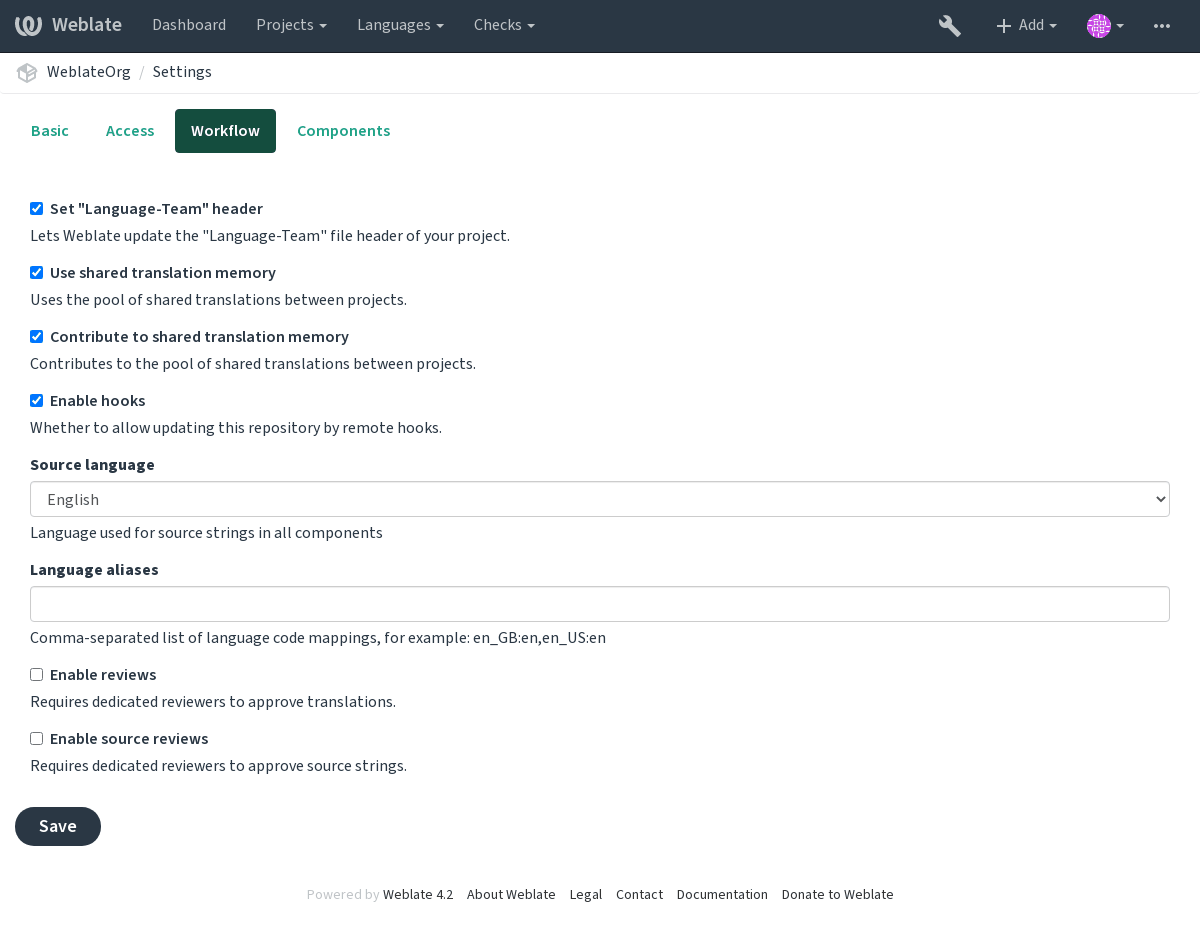Flujos de trabajo de traducción¶
Se admiten varios flujos de trabajo de traducción.
La siguiente no es una lista completa de maneras de configurar Weblate. Puede basar otros flujos de trabajo en los ejemplos más usuales que se enumeran aquí.
Acceso de traducción¶
The Control de acceso is not much discussed in the workflows as each access control option can be applied to any workflow. Please consult that documentation for information on how to manage access to translations.
In the following chapters, any user means a user who has access to the translation. It can be any authenticated user if the project is public, or a user that has a Translate permission for the project.
Translation states¶
Cada cadena traducida se clasifica en uno de los estados siguientes:
- No traducidas
Translation is empty, it might or not be stored in the file, depending on the file format.
- Necesita edición
Translation needs editing, this is usually the result of a source string change. The translation is stored in the file, depending on the file format it might be marked as needing edit (for example as it gets a fuzzy flag).
- Revisión pendiente
La traducción se ha efectuado pero no se ha revisado. Está almacenada en el archivo y es válida.
- Aprobadas
Translation has been approved in the review. It can no longer be changed by translators, but only by reviewers. Translators can only add suggestions to it.
- Sugerencias
Las sugerencias se almacenan solo en Weblate, no en el archivo de traducción.
Traducción directa¶
This is most usual setup for smaller teams, anybody can directly translate. This is also the default setup in Weblate.
Any user can edit translations.
Suggestions are optional ways to suggest changes, when translators are not sure about the change.
Configuración |
Value |
Nota |
|---|---|---|
Activar revisiones |
desactivada |
Configured at project level. |
Activar sugerencias |
activada |
It is useful for users to be able to suggest when they are not sure. |
Votar sugerencias |
desactivada |
|
Autoaceptar sugerencias |
0 |
|
Grupo de traductores |
Users |
Or Translate with Control de acceso. |
Grupo de revisores |
Sin datos |
Not used. |
Revisión por pares¶
With this workflow, anybody can add suggestions, and need approval from additional member(s) before it is accepted as a translation.
Any user can add suggestions.
Any user can vote for suggestions.
Suggestions become translations when given a predetermined number of votes.
Configuración |
Value |
Nota |
|---|---|---|
Activar revisiones |
desactivada |
Configured at project level. |
Activar sugerencias |
activada |
|
Votar sugerencias |
desactivada |
|
Autoaceptar sugerencias |
1 |
You can set higher value to require more peer reviews. |
Grupo de traductores |
Users |
Or Translate with Control de acceso. |
Grupo de revisores |
Sin datos |
Not used, all translators review. |
Revisores dedicados¶
Nuevo en la versión 2.18: The proper review workflow is supported since Weblate 2.18.
Al activar los revisores dedicados dividirá sus usuarios en dos grupos: uno será capaz de enviar traducciones, y el otro podrá revisarlas para garantizar que sean coherentes y su calidad sea buena.
Cualquier usuario puede editar traducciones no aprobadas.
Los revisores pueden aprobar o desaprobar las cadenas.
Los revisores pueden editar todas las traducciones (incluidas las aprobadas).
Es posible asimismo emplear las sugerencias para proponer modificaciones a las cadenas aprobadas.
Configuración |
Value |
Nota |
|---|---|---|
Activar revisiones |
activada |
Configured at project level. |
Activar sugerencias |
desactivada |
It is useful for users to be able to suggest when they are not sure. |
Votar sugerencias |
desactivada |
|
Autoaceptar sugerencias |
0 |
|
Grupo de traductores |
Users |
Or Translate with Control de acceso. |
Grupo de revisores |
Reviewers |
Or Review with Control de acceso. |
Turning on reviews¶
Reviews can be turned on in the project configuration, from the Workflow subpage of project settings (to be found in the Manage → Settings menu):

Nota
Depending on Weblate configuration, the setting might not be available to you. For example on Hosted Weblate this is not available for projects hosted for free.
Quality gateway for the source strings¶
In many cases the original source language strings are coming from developers, because they write the code and provide initial strings. However developers are often not a native speakers in the source language and do not provide desired quality of the source strings. The intermediate translation can help you in addressing this - there is additional quality gateway for the strings between developers and translators and users.
By setting Archivo de idioma intermediario, this file will be used as source for the strings, but it will be edited to source language to polish it. Once the string is ready in the source language, it will be also available for translators to translate into additional languages.
Source strings reviews¶
With Activar revisiones de origen enabled, the review process can be applied on the source strings. Once enabled, users can report issues in the source strings. The actual process depends on whether you use bilingual or monolingual formats.
For monolingual formats, the source string review behaves similarly as with Revisores dedicados - once issue is reported on the source string, it is marked as Needs editing.
The bilingual formats do not allow direct editing of the source strings (these are typically extracted directly from the source code). In this case Source needs review label is attached to strings reported by translators. You should review such strings and either edit them in the source or remove the label.